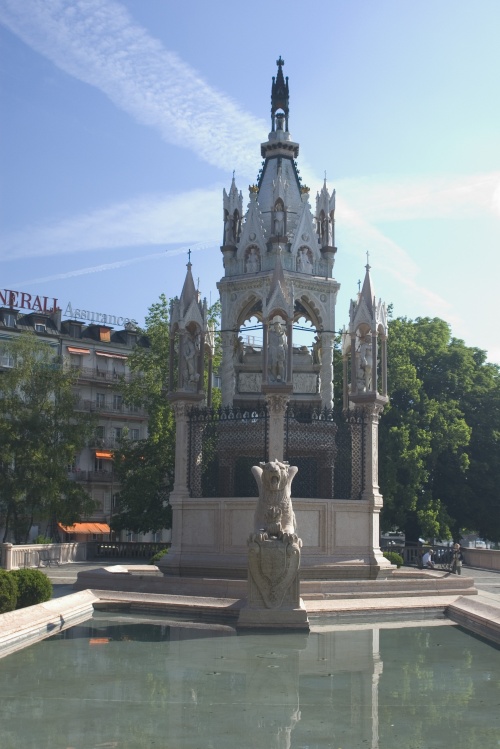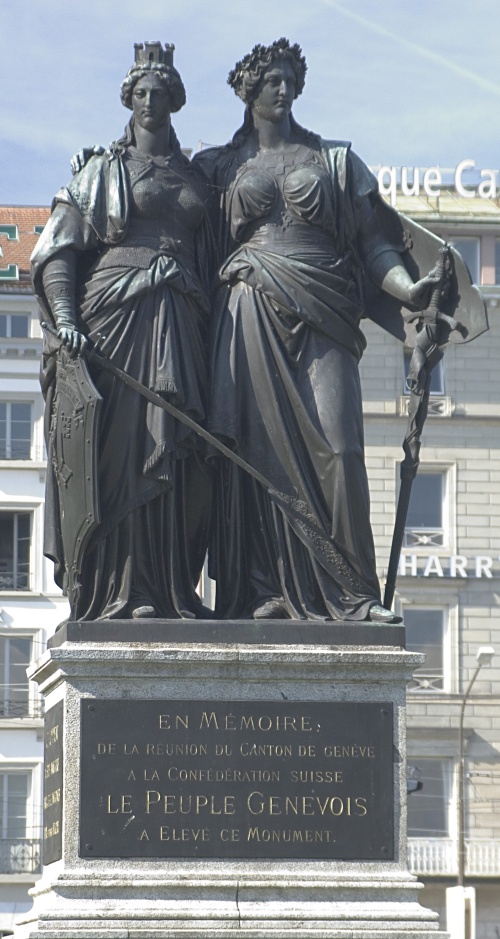Geneva - June 2004

British Airways had a cheap flight to Geneva, and I had only passed through Zurich once a very long time ago, so I decided to pay Switzerland a visit.
I was very keen to see all the interesting things Geneva had to offer, like the United Nations building, the Red Cross, CERN and so on.
But unfortunately Geneva wasn't playing along, and the first two days it rained almost constantly, making sightseeing next to impossible.
One of the more spectacular sights in Geneva is the fountain, the Jet d'Eau.
This is a 140 meter
high water monument, mounting rapidly into the sky and then falling down
again in millions of drops as a curtain with thousands of constantly renewed
folds.
The Jet d’Eau of Geneva has a rich history. Originally it was the safety
valve for a hydraulic plant, at the time when electricity was still a
laboratory curiosity. Today it works through motor-driven pumps and its
capacity is 500 litres per second. It works from the beginning of March till
mid-October.
At Saint Peter's Cathedral 157 steps lead to the summit of the cathedral's north tower and to a fabulous panorama overlooking the city and the lake. You will also be charmed by the Clémence, the queen of the bells, weighing over 6 tons and hoisted to this very tower in 1407. The first phase of the cathedral's construction dates back to the year 1160 and lasted nearly a century. Many events, including a series of fires, led to restorations and reconstructions, modifying its original design. Then, in the middle of the 16th century, the advent of the Reformation, with its philosophy of austerity, upset the entire interior of the building. All ornaments were removed and the coloured decors whitewashed. Only the stained glass windows were spared. Its current neo-classic facade dates from the middle of the 18th century, having replaced the former Gothic one.
At the Brunswick Monument you will find the tomb of Charles II of Brunswick, who died in Geneva in 1873. The duke left his fortune to the city with the provision that it build a monument to him. Geneva accepted the fortune and modelled the tomb after the Scaglieri tombs in Verona. So, if you're very rich and want to be buried in style, you know where to go.
The English Garden, dating from 1854, is home to the Monument National, a statue of two young women – the ‘Republic of Geneva’ and ‘Helvetia’ – symbolising Geneva’s attachment to the Swiss Confederation on 12 September 1814. They seemed very friendly ladies to me, just don't ask if they are lesbians!
Within the park there
is an elegant bronze fountain and L’Horloge Fleurie (Flower Clock) –
decorated with over 6300 plants – that was installed in 1955 to honour
Geneva’s watch-making industry. The clock is the largest in the world – five
metres (16.4ft) in diameter and 17.7m (58ft) in circumference. Its second
hand advances nearly 27cm (10.6 inches) per second.

The Jet d'Eau on the lake in Geneva, WOW!

St. Peter's Cathedral

The Brunswick Monument

Geneva and Helvetia